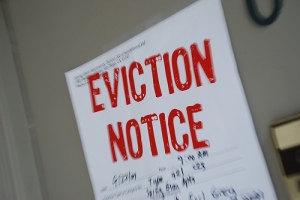This is part 8 of my blog series about dealing with threatening and violent residents.
 If the behavior by the resident is physically threatening or violent, a restraining order prohibiting the resident from having contact with the employee may be the best solution. A restraining order is actually a stay away order prohibiting the resident from harassing, threatening, assaulting and contacting the employee and requiring the resident to stay a certain amount of feet away from the employee.
If the behavior by the resident is physically threatening or violent, a restraining order prohibiting the resident from having contact with the employee may be the best solution. A restraining order is actually a stay away order prohibiting the resident from harassing, threatening, assaulting and contacting the employee and requiring the resident to stay a certain amount of feet away from the employee.
A restraining order consists of the employee (or attorney of employee) filling out temporary restraining order forms and filing them with the appropriate court. These forms can be obtained on the Internet and downloaded. Most court websites provide these forms along with simple instructions on how to fill them out.
After the papers are filed with the court, a judge typically reviews the paperwork and takes testimony of the employees seeking the restraining order to determine if there is an imminent threat to the employee posed by the resident. Employees seeking restraining orders should make sure they have any police reports or witness statements with them prior to seeing the judge. The initial court appearance for a restraining order is to seek a temporary order at which a hearing for a permanent order will be set within a few weeks. At the hearing for the permanent injunction, the resident will be requested to appear and will have an opportunity to present evidence and defend him or herself. If at the hearing, the judge believes the restraining order is necessary to protect the employee, the order will stay in effect for three years.
Since the resident resides in the community where the manager/employee works and lives, the judge may modify the order to address this, such as by reducing the number of feet the resident must stay away from the employee or by requiring the resident to drop his rent in the drop box after hours to avoid resident contact with the manager/on-site employee. The restraining order should include the employee’s family members or others living on-site with the employee.
* For specific inquiries regarding a threatening/violent tenant you may have, you’re welcome to visit my California Manufactured Housing Community Owners legal services page.
 As you are aware, a resident can be evicted for threatening and aggressive behavior either under violation of a reasonable rule and regulation (798.56(d)) and/or a substantial annoyance eviction (798.56(b)). By indicating in your rules that this type of behavior is prohibited and constitutes a substantial annoyance, and by serving the appropriate notices and obtaining substantial documentation supporting this (written witness statements, restraining orders, police reports etc.), a 60-day notice for termination of tenancy can be a very effective way to protect the employee against an abusive, violent resident.
As you are aware, a resident can be evicted for threatening and aggressive behavior either under violation of a reasonable rule and regulation (798.56(d)) and/or a substantial annoyance eviction (798.56(b)). By indicating in your rules that this type of behavior is prohibited and constitutes a substantial annoyance, and by serving the appropriate notices and obtaining substantial documentation supporting this (written witness statements, restraining orders, police reports etc.), a 60-day notice for termination of tenancy can be a very effective way to protect the employee against an abusive, violent resident.